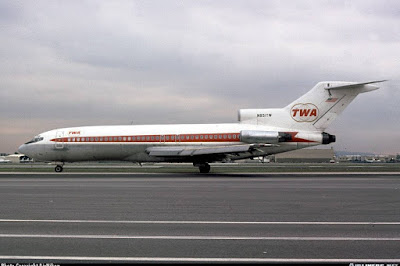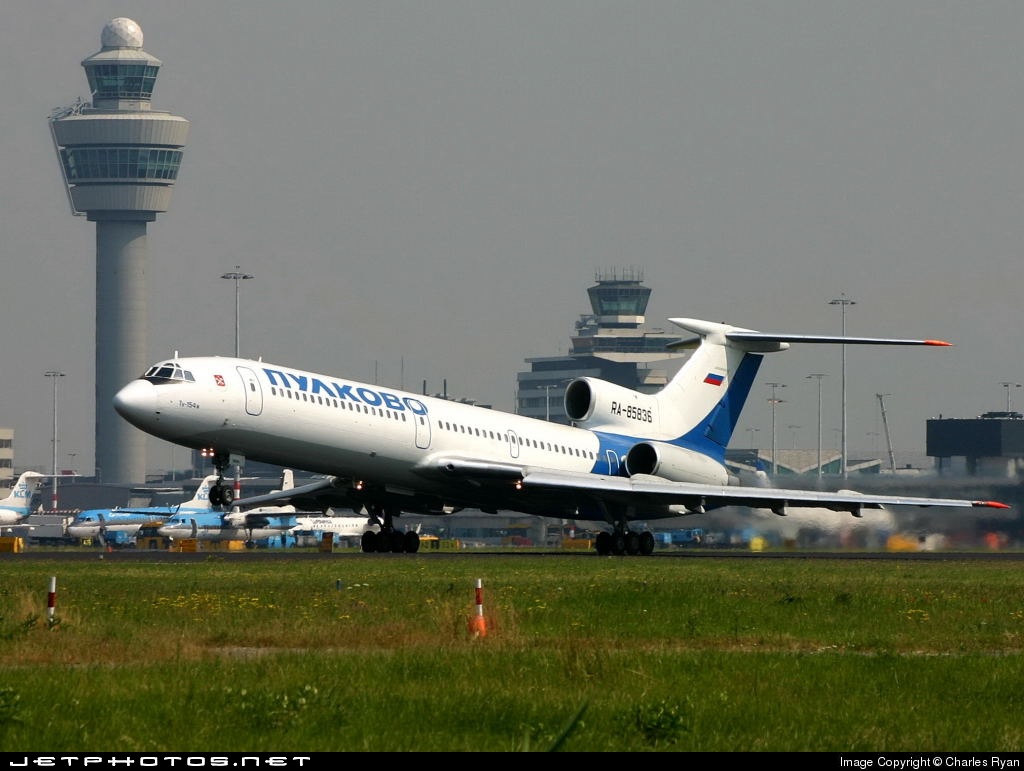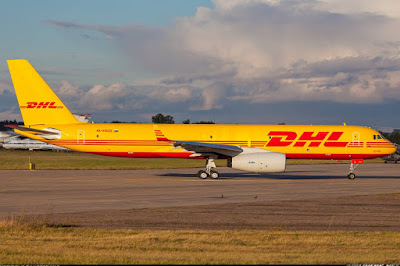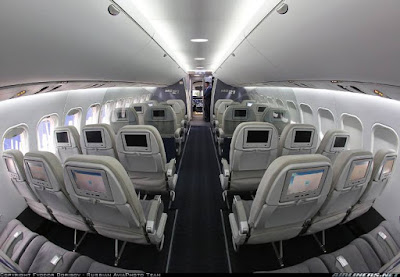For my part 4: Common Turboprop Aircraft, click here
For my part 5: Antonov, BAC, Fokker (Jets), Lockheed, D.H Comet, click here
*Photos are credited to the respective photographers from airliners.net and jetphotos.net
There are so many different Russian types, so I list the common ones. Unfortunately this era, there are not many Russian jets flying around, so if you spot one you have an idea why some of us get excited.
Hope you find this guide useful!
This is Pulkovo Airlines Tupolev TU-154M, I photographed this at Düsseldorf Airport.
Tupolev
Tupolev is a Russian aerospace and defence company based in Basmanny District in Moscow formed in 1922. It is officially known is Joint Stock Company Tupolev. This company is the successor of Tupolev Design Bureau headed by a Soviet Union Aerospace Engineer called A.N Tupolev.
TU-104 - Camel
This aircraft was built in the middle of 1950s to compete with the Western first-generation jets such as the D.H Comet and Caravelle. It was a twin-jet medium size narrow-body jet airliner built to cater to the needs of the Russian airlines. Aeroflot was the launch customer of this aircraft type.
There is a different variant of this aircraft type but basically, an improvement to the fuselage and engines as technology got better during those days. There is also a VIP version that carries the important people around.
Technical specification of the TU-104B
Capacity: 50-115 passengers
Range: 2,750 km
This is how a TU-104 looks like
TU-104 - Camel
This aircraft was built in the middle of 1950s to compete with the Western first-generation jets such as the D.H Comet and Caravelle. It was a twin-jet medium size narrow-body jet airliner built to cater to the needs of the Russian airlines. Aeroflot was the launch customer of this aircraft type.
There is a different variant of this aircraft type but basically, an improvement to the fuselage and engines as technology got better during those days. There is also a VIP version that carries the important people around.
Technical specification of the TU-104B
Capacity: 50-115 passengers
Range: 2,750 km
This is how a TU-104 looks like
TU-114 -Rossiya
The Tupolev TU-114 Rossiya is a turboprop long-range aircraft built in the USSR in 1955, it was the largest and fastest aircraft at that time and able to accommodate up to 224 passengers. This aircraft design is based on TU-95 strategic bomber and has similarity to it such as basic wing, landing gear, and engine type.
This is how a TU-95 aircraft looks like
The capacity of the TU-114: 120-220 passengers
Range of the TU-114: 9,720 km
Here are some photos of the TU-114
TU-124 - Cookpot
Developed from the TU-104, this is an improved version to meet Aeroflot's requirement for the replacement of IL-14 aircraft on regional routes. It looks around 75% of TU-104 and it is difficult to tell apart between the -104 and 124. The -124 has improved features such as double-slotted flaps, a large centre-section air brake, and automatic spoilers.
Capacity: 56 passengers
Range: 2,100 km
These are the photos of the TU-124.
Photo: Petr Popular Collection (below)
TU-134 - Crusty
This aircraft is a twin-engined jet built in USSR from 1966 to 1984. It was one of the most widely used aircraft during its golden days but gradually the numbers were reduced due to engine noise and newer aircraft available during that period. The French introduced the first aircraft equipped with engines attached to the rear fuselage just below the tail of the aircraft, the Caravelle.
This is how the SUD SE-210 Caravelle looks like
The capacity of the TU-134: 72-84 passengers
Range of the TU-134: 1,900 to 3,000 km
Here is a photo of the TU-134A
TU-144
The TU-144 is the least successful aircraft among the Tupolev aircraft. Only 16 of this supersonic transport aircraft were built. It is a rival of the Concorde and flew 2 months before the first Concorde took the skies. The design of this aircraft was officially announced in 1962 and went supersonic on 5th June 1969. However, one of the aircraft crashed during the Paris Air Show in 1973 causing a delayed in development of the aircraft for a further 2 years. The aircraft was finally put on service in 1977, 2 years behind the Concorde's introduction. The last straw came when one of the TU-144M (An improved version) crashed while on delivery to an airline and that halted an end to the commercial service to this aircraft type.
This is the comparison between the Concorde and TU-144 SST (SuperSonic Transport)
Concorde - unfortunately, the airliner stopped flying after the Paris Air Crash.
Tupolev TU-144
Capacity: 140 passengers
Range: 7,500 km
Speed: Mach 2.15 (2,120 km/h)
TU-154
This is one of the most popular aircraft for Tupolev company as it sells more than the other types, mainly in Eastern Europe and Russian airlines. Equipped with 3 engines located at the rear fuselage, it was designed in mid-1960 and the first flight took place on October 1968. This aircraft was built to replace the TU-104, requested specifically from Aeroflot. This aircraft is a competitor to Hawker Siddeley Trident and Boeing's 727 aircraft, flying with similar capacity on short-medium range routes.
The competitors:
Hawker Siddeley HS-121 Trident
Boeing 727-100
TU-154 - Careless
Range: TU-154B-2: 2,500 km to 3,900 km
TU-154M: 5,280 km to 6,600 km
Capacity: (Both versions) - 114-180 passengers
This is the TU-154M version - this has the improved western avionics for the pilots and can fly longer range than the B-2 version.
Pulkovo Aviation's TU-154M lifting off at Amsterdam!
North Korea's Air Koryo TU-154B-2
TU-204/TU-214
The Tupolev TU-204 is a single-aisle twin-jet aircraft capable of carrying 210 passengers introduced in 1989. Similar in size to the Boeing 757, this aircraft has competitive performance but lacks the range and payload. The manufacturer has improved a few versions to make it more competitive especially when the Airbus A321 joined in the competition. The TU-214 aircraft is similar to the TU-204-200 version, the main difference is both aircraft are built in different factories. TU-204 is built-in Ulyanovsk - Aviastar SP while TU-214 is built-in Kazan Aircraft Production Association.
Capacity: TU-204-100/-120 - 190-210 passengers
TU-214 - 180-210 passengers
TU-214-300 - 142-156 passengers
TU-214SM - 176-215 passengers
Range: TU-204-100 - 4,300 km
TU-204-120 - 4,100 km
TU-214 - 4,340 km
TU-204-300 - 5,800 km
TU-204SM - 4,200 km
This is TU-204-100V operated by Air Koryo.
Doesn't this look like the Boeing 757?
This is Boeing 757-200
The TU-204 also comes in the Freighter version.
This is DHL's TU-204T
Transaero's TU-214
Sukhoi
Sukhoi Company (JSC) is a major Russian aircraft manufacturer based in Moscow and was set up in 1939. This manufacturer built mostly military aircraft and introduced the first civilian aircraft in the form of Superjet 100 in September 2007. It decided to venture in commercial aviation to enjoy some a slice of pie in the competitive market. The Superjet 100 is designed to carry between 75 to 108 passengers and fly on short-medium thin routes. It made its first flight in 19th May 2008 and Armavia is the launch customer for this aircraft. It is designed to compete against AN-158, Bombardier CRJ series and Embraer ERJ series.
Capacity: SSJ100- 75 and -75LR - 68-88 passengers
SSJ100- 95 and -95LR - 86-108 passengers
Range: SSJ-100 -75 - 2,900 km
SSJ-100 -75LR - 4,550 km
SSJ-100- 95 - 3,048 km
SSJ-100-95LR - 4,578 km
My photo of this aircraft at the Paris Air Show in 2011.
This aircraft is a twin-engined jet built in USSR from 1966 to 1984. It was one of the most widely used aircraft during its golden days but gradually the numbers were reduced due to engine noise and newer aircraft available during that period. The French introduced the first aircraft equipped with engines attached to the rear fuselage just below the tail of the aircraft, the Caravelle.
This is how the SUD SE-210 Caravelle looks like
The capacity of the TU-134: 72-84 passengers
Range of the TU-134: 1,900 to 3,000 km
Here is a photo of the TU-134A
TU-144
The TU-144 is the least successful aircraft among the Tupolev aircraft. Only 16 of this supersonic transport aircraft were built. It is a rival of the Concorde and flew 2 months before the first Concorde took the skies. The design of this aircraft was officially announced in 1962 and went supersonic on 5th June 1969. However, one of the aircraft crashed during the Paris Air Show in 1973 causing a delayed in development of the aircraft for a further 2 years. The aircraft was finally put on service in 1977, 2 years behind the Concorde's introduction. The last straw came when one of the TU-144M (An improved version) crashed while on delivery to an airline and that halted an end to the commercial service to this aircraft type.
This is the comparison between the Concorde and TU-144 SST (SuperSonic Transport)
Concorde - unfortunately, the airliner stopped flying after the Paris Air Crash.
Tupolev TU-144
Capacity: 140 passengers
Range: 7,500 km
Speed: Mach 2.15 (2,120 km/h)
This is one of the most popular aircraft for Tupolev company as it sells more than the other types, mainly in Eastern Europe and Russian airlines. Equipped with 3 engines located at the rear fuselage, it was designed in mid-1960 and the first flight took place on October 1968. This aircraft was built to replace the TU-104, requested specifically from Aeroflot. This aircraft is a competitor to Hawker Siddeley Trident and Boeing's 727 aircraft, flying with similar capacity on short-medium range routes.
The competitors:
Hawker Siddeley HS-121 Trident
Boeing 727-100
TU-154 - Careless
Range: TU-154B-2: 2,500 km to 3,900 km
TU-154M: 5,280 km to 6,600 km
Capacity: (Both versions) - 114-180 passengers
This is the TU-154M version - this has the improved western avionics for the pilots and can fly longer range than the B-2 version.
Pulkovo Aviation's TU-154M lifting off at Amsterdam!
North Korea's Air Koryo TU-154B-2
TU-204/TU-214
The Tupolev TU-204 is a single-aisle twin-jet aircraft capable of carrying 210 passengers introduced in 1989. Similar in size to the Boeing 757, this aircraft has competitive performance but lacks the range and payload. The manufacturer has improved a few versions to make it more competitive especially when the Airbus A321 joined in the competition. The TU-214 aircraft is similar to the TU-204-200 version, the main difference is both aircraft are built in different factories. TU-204 is built-in Ulyanovsk - Aviastar SP while TU-214 is built-in Kazan Aircraft Production Association.
Capacity: TU-204-100/-120 - 190-210 passengers
TU-214 - 180-210 passengers
TU-214-300 - 142-156 passengers
TU-214SM - 176-215 passengers
Range: TU-204-100 - 4,300 km
TU-204-120 - 4,100 km
TU-214 - 4,340 km
TU-204-300 - 5,800 km
TU-204SM - 4,200 km
This is TU-204-100V operated by Air Koryo.
Doesn't this look like the Boeing 757?
This is Boeing 757-200
The TU-204 also comes in the Freighter version.
This is DHL's TU-204T
Transaero's TU-214
Sukhoi
Capacity: SSJ100- 75 and -75LR - 68-88 passengers
SSJ100- 95 and -95LR - 86-108 passengers
Range: SSJ-100 -75 - 2,900 km
SSJ-100 -75LR - 4,550 km
SSJ-100- 95 - 3,048 km
SSJ-100-95LR - 4,578 km
My photo of this aircraft at the Paris Air Show in 2011.
Red Wings SSJ-100-95B (Photo: Varani Ennio)
Ilyushin
Ilyushin is a Russian aircraft manufacturer known as Open Joint Stock Company (Ilyushin Aviation Complex) started operation in 1933 and based in Moscow. The aircraft below are some of the many aircraft this manufacturer has built. In July 2014, this company along with Myasishchev would merge to form the United Aircraft Corporation business unit - Transport Aircraft.
lL-12
This aircraft looks similar to Douglas DC-3, right? It is, in fact, a license-produced DC-3, a replacement for the Lisunov Li-2 aircraft. The first aircraft was introduced after the 2nd world war in May 1947, and the commercial service of this aircraft type began a month later with Aeroflot operating this aircraft. 663 of this aircraft was built and later on, the improved version of this aircraft became IL-14.
Capacity: 21-32 passengers
Range: 1,500 km with 26 pax
This is Aeroflot's IL-12.
lL-14
This aircraft was a vast improvement over IL-12 featuring new wing and broader tail fin making it a popular model over the older sibling. It served both military and commercial transportation and the order of this aircraft was at least doubled over IL-12.
Range: 1,305 km
Capacity: 24-32 passengers
This is Balkan-Bulgarian Airlines lL-14.
lL-18 - Coot
This aircraft was built in 1958 and featured 4 turboprop engines. It became one of the most successful aircraft in its time as its well knew for being durable and reliable. The first aircraft took its first flight on 4th July 1957 and incredibly some are flying up till today!
Capacity: 65-120 passengers
Range: 3,700 - 6,500 km
One of the few surviving IL-18 in 2015 and Air Koryo is one of the few operators.
lL-62
This aircraft is well known for its 4 rear-mounted engines narrow-body which looks similar to British's aircraft - VC-10. It is built to replace the IL-18 and is designed to carry 200 passengers on long-range flights. This aircraft first flew in 1963 and started commercial service with Aeroflot in 1967. This aircraft was significant for Russian aviation as it was the aircraft back then to have a pressurized cabin with non-circular cross-section fuselage and ergonomic passenger door and also the first to have 6-abreast seating and international standard position lights. There are a few versions of this model.
lL-62, IL-l2M, and lL-62MK
lL-62 is the standard model.
l
lL62M is powered with slightly more powerful engines and comes with improved cabin and aerodynamics.
lL-62MK has lesser range than the other two but carries more passengers.
Capacity: 168-186 passengers
Range: (Standard model): 10000 km
Panning shot of Russia - Air Force ll-62M
CSA lL-62
This is Vickers VC-10 (British built aircraft) Do they look alike?
IL-76 - Candid
This is a multi-purpose 4-engined turbofan aircraft built for cargo airlines and also a replacement for Antonov- AN 12 aircraft. It was designed to carry heavy machinery on remote areas in Russia. This cargo aircraft first flew on March 1971 and modernize modification were added to the aircraft in the early 1990s and finally ended production in the late 1990s.
Range: 4,000 km
Russian cargo operator - Volga-Dnepr Airlines
Silkway Airlines lL-76TD
lL-86 - Camber
This aircraft is the first 4-engine wide-body jet built for short-medium haul routes that required capacity. The difference between this and lL-96 from the appearance is that this aircraft has no winglets and fuselage is longer. Built-in the 1970s, Aeroflot and some post-Soviet airlines were the main operators of this aircraft type. Production of this aircraft started in 1976 and it flew for its first time on October 1977.
Capacity: 3-Class ( 320 passengers)
1-Class ( 350 passengers)
Range: 3,400 km to 5,000 km depends on loading
This is Pulkovo's IL-86
S7's lL-86 aircraft
lL-96
This aircraft first flown in 1988 and started commercial service with Aeroflot in 1993. It was built to hold lesser capacity than the lL-86 but can fly further and had more advanced technology on this aircraft type. This aircraft was fitted with supercritical wings fitted with winglets, a glass cockpit, and a fly-by-wire control system. There are a few variants of this aircraft type: lL-96-300, lL-96M, lL-96T, lL-96-400 and lL-96-400TZ
-300 series: This is the original configuration
M series: a Stretched version of the -300, fitted with Western-style avionics and equipped with Western engines - Pratt and Whitney.
T series: Freighter version
-400 series: Similar to M series but features Russian avionics and engines
-TZ series: Tank variant, built for the military
Capacity: -300 series - 237-300 passengers
-M series - 307-230 passengers
-400 series - 315-436 passengers
Range: -300 series - 11,500 to 13,500 km
-M series - 12,800 to 15,000 km
-T series - 5,000 to 12,000 km
-TZ series - 10,000 to 12,000 km
Cubana's lL-76-300
This is Cubana's lL-96-300 in Aeroflot livery.
This is the longer version - Polet Airlines'lL-96-400T (Freighter)
lL-114
This aircraft was designed by the aircraft manufacturer to cater to the needs for domestic routes. It is a twin-engine turboprop and built to compete with Antonov's AN-24. The first flight took place on March 1990 but the 2nd type crashed during flight testing cause lots of issues to be ironed up and that included the withdrawal of funding from the Russian government. Finally, it was certified to fly in April 1997, however, the damage was already done. Only 20 aircraft of this variant was built.
Capacity: 64 passengers
Range: 1,000 km
This is Radar's aircraft
Vyborg's lL-114 aircraft
Market
This is a Russian manufacturer, one of the members of the United Aircraft Corporation. United Aircraft Corporation is majority-owned by the government and this company consolidates Russian private and state-owned aircraft manufacturing companies and does the sales of the military, commercial, transport and unmanned aircraft. The manufacturing companies are Irkut, Ilyushin, Mikoyan, Sukhoi, Tupolev, and Yakovlev.
Irkut produced Sukhoi SU-27, SU-30, and amphibious aircraft and now working on the MC-21, one of the latest commercial airliners in the Russian Aviation.
MC-21 (MS-21)
This is a series of 3 short-medium range aircraft to compete with Airbus A320 and Boeing 737, especially in the Russian market. This aircraft is designed based on Yakovlev's Yak-242 which was meant to be replaced by the Yak-42 aircraft. This MC-21 is currently still undergoing production and it will make its first flight in 2016 and first delivery to take place a year later. There are 2 variants of this aircraft type: -200 and -300 while the -400 is still at the planning stage.
-200: the Shortened version which carries up to 176 passengers
-300: Standard version which carries up to 211 passengers
-400: the Planned stretched version which carries up to 230 passengers
Range: -200 - 6,000 km
-300 - 5,900 km
-400 - 5,500 km
Currently, there is no photo of the actual aircraft. I will post once they are up.
Here are the interior shots of the mock-up model, thanks to the Russian aviation enthusiasts.
MC-21 aircraft
The cockpit of the MC-21
The modern cabin of the mock-up MC-21.
Yakovlev
This is also another aircraft designer and manufacturer based in Moscow. Set up in 1934 by designer Alexander Sergeyevich Yakovlev, this company built fighter jets. In April 2004, this company was absorbed by Irkut and later on was merged with other carriers to form United Aircraft Building Corporation in February 2006 by the government.
Yak-42
The manufacturer designed this 3-engine Yak-42 aircraft in 1972 for short-medium range routes and can carry 100-120 passengers. It was built after the Yak-40, with the longer fuselage (carry slightly more seats), can fly further and have improved aerodynamics over its elder sibling.
It was intended to replace the TU-134 and all-18 aircraft, AN-24 and AN-26 aircraft. The first flight took place in 1975 and made its maiden flight at the end of 1980 with Aeroflot launching this aircraft type. However, the aircraft had its own share of the problem especially after one of them crashed when the tailplane was detached while flying mid-flight causing the aircraft type to be grounded for around 2 years before it was allowed to fly again. There are many variants of this aircraft type, catering the needs for the airlines.
Capacity: Up to 120 passengers
Range: 4,000 km
This is Yak-42D (Photo: Osipov Dmitry)
Yak-40 Photos (Can you spot the difference?)
This is Yak-40
This is Yak-42
That's all for this part 3, more parts to come. The next part will be Turboprops from ATR, Bombardier and some others. Stay tuned!
You can check out the other parts over here
Part 1: Click here
Part 2: Click here
Part 4: Click here
Part 5: Click here
Thanks for reading! If there are any errors, please let me know.
Cheers,
Charles















































No comments:
Post a Comment